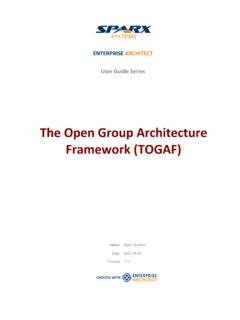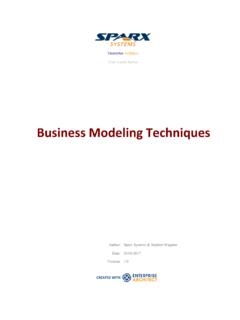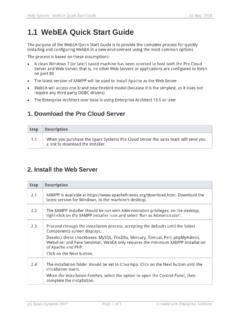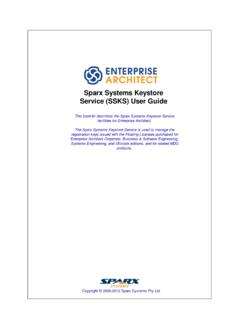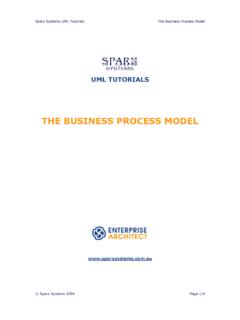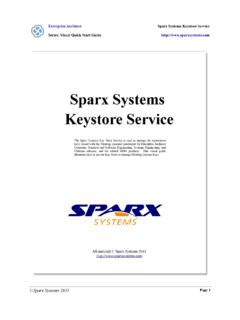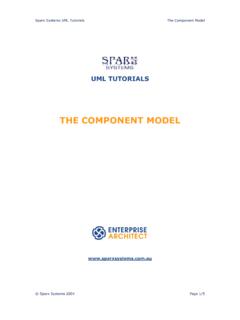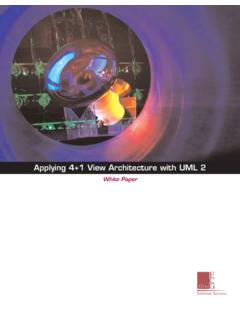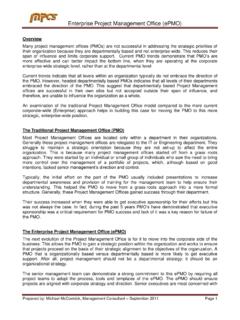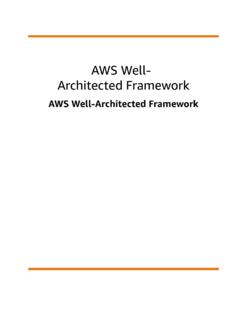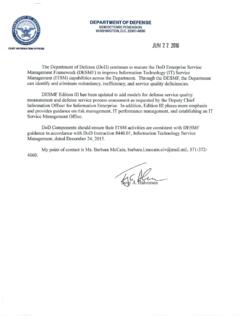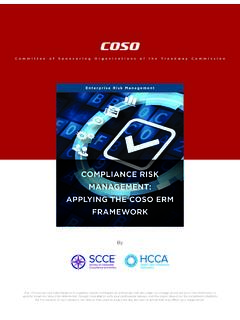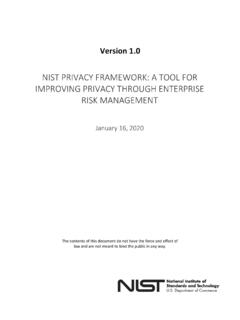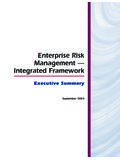Transcription of Enterprise Architecture
1 Enterprise Architect User Guide Series Enterprise Architecture How to model Enterprise Architecture ? Sparx Systems Enterprise Architect helps visualize an Enterprise at different levels of abstraction, the strategic context of its Architecture , its evolution from a current to a future state and its implementation. Author: Sparx Systems & Stephen Maguire Date: 2020-01-20. Version: CREATED WITH. Table of Contents Enterprise Architecture 6. Introduction 8. Enterprise Architecture Overview 12. What is Enterprise Architecture 13. Context for Enterprise Architecture 14.
2 Levels of Architecture 17. Types of Architecture 20. Scope of Architecture 26. Characteristics of Good Architecture 32. Lists Diagrams and Matrices 35. Meet the Enterprise Architecture Tools 39. Activity Diagram 40. Auditing 42. Balanced Scorecard 44. Business Process Diagram 46. Calendar 48. Class Diagram 50. Component Diagram 52. Dashboard Diagrams 54. Decision Tree Diagram 56. Deployment Diagram 58. Documentation 60. Gap Analysis Matrix 62. Heat Map 64. Import and Export Spreadsheets 65. Organizational Chart Diagram 66. Patterns 68. Relationship Matrix 70. Requirements Diagram 72.
3 Roadmap Diagram 75. Specification Manager 77. Strategy Map 79. Team Library 81. Time Aware Modeling 83. Traceability Window 85. Value Chain 87. Uses of an Enterprise Architecture 89. Mergers and Acquisitions 90. Corporate Divestiture 91. Architecture Oversight 92. Business and Systems Improvement 93. Communication 94. Enterprise Transitions 95. Implementation Guide 96. Portfolio Management 97. Architecture Program Set Up 98. Management Structure 99. Architecture Framework 103. Architecture Process 104. Architecture Repository 108. Tool Set Up 111. Architecture Principles 126.
4 Managing an Enterprise Architecture 128. Architecture Governance 129. Governance Process 130. Architecture Steering Committee 131. Architecture Review Board 133. Governance Register 136. Developing an Enterprise Architecture 137. Architectures 138. Business Architecture 140. Strategic Plans 141. Mission and Vision 143. Drivers 144. Goals and Objectives 146. Capabilities 148. Business Processes 150. Information Architecture 153. Conceptual Information Model 154. Logical Data Model 157. Schemas and Messages 158. Physical Data Model 159. Application Architecture 161.
5 Application Lists Diagrams and Matrices 162. Application Communication 166. Interface Lists 168. Capabilities and Applications 169. Business Processes and Applications 171. Technology Architecture 173. Application Platform Services 174. Technical Reference Model 176. Infrastructure Facilities 178. Stakeholder Modeling 180. Requirements Modeling 183. Documenting an Enterprise Architecture 185. Architecture Description 186. Architecture Requirements Specification 187. Architecture Vision 188. Communication Plan 189. Compliance Assessment 190. Project Glossary 191.
6 Enterprise Architecture Techniques 192. Architecture Governance 193. Architecture Requirements Management 195. Architecture Partitioning 198. Application Portfolio Management 200. Balanced Scorecard 203. Baselines and Versioning 205. Business Goals and Objectives Modeling 207. Business Scenarios 210. Capability Based Planning 213. Capability Modeling 214. Compliance Assessment 217. Concept Modeling 218. Data Modeling 221. Driver Modeling 223. Functional Decomposition 225. Gap Analysis 228. Glossary 230. Interface Analysis 231. Mind Mapping 233. Organizational Modeling 235.
7 Pattern Analysis 237. Principles Management 239. Process Analysis 241. Process Modeling 243. Reviews 246. Risk Analysis and Management 247. Roadmaps 249. Stakeholder Management 251. Standards Modeling 258. Technical Reference Model 260. Time Aware Modeling 263. Use Cases and Scenarios 266. Views and Viewpoints 268. Workshops 272. Additional Enterprise Architecture Tools 276. Auto Names and Counters 277. Baseline Tool 279. Boundary 281. Document Artifact 284. Element Discussions 286. Glossary 288. Image Manager 290. List View 292. Mind Mapping Diagram 294. Model Mail 296.
8 Model Views 298. Model Search 300. Package Browser 302. Pan and Zoom 304. Browser window 306. Requirements Checklist 309. Requirement Properties 311. Risk Taxonomy 314. Security 316. Stereotyping 318. Tagged Values 320. Visual Filters 322. Working Sets 324. Enterprise Architecture - Enterprise Architecture 20 January, 2020. Enterprise Architecture Enterprise Architecture has emerged as a discipline that can help steer the 'ship' of the Enterprise through both quiet and turbulent waters, charting a course from its current location to a future location in a safe and streamlined way.
9 The discipline has become more prevalent in recent years, but the precepts go back almost to the beginning of what is often termed the information age. An Enterprise is one of the most complex man-made systems and is composed of human, political, social, software, hardware and technology components. In an Enterprise of any appreciable size, it is impossible for a single person to understand the way the parts all work together, let alone understand its position in relation to the system of other organizations that form its environment, or to determine how it can evolve.
10 Enterprise Architecture can be used to create visualizations of the Enterprise at different levels of abstractions and to create Roadmaps that show how the Enterprise can be transitioned from its baseline (current) state to a target (future). state. Unit: Quarterly Component Lifecycle Q4'12 Q1'13 Q2'13 Q3'13 Q4'13 Q1'14 Q2'14 Q3'14 Q4'14 Q1'15 Q2'15 Q3'15 Q4'15 Q1'16 Q2'16 Q3'16 Q4'16 Q1'17 Q2'17 Q3'17 Q4'17 Q1'18 Q2'18. Windows 10. Enterprise Resource Planning System Customer Manager This development represents the Capture CRM Hosted Service refactoring from a thick client to a web- based interface maintaining the server side component developed in 2002.
